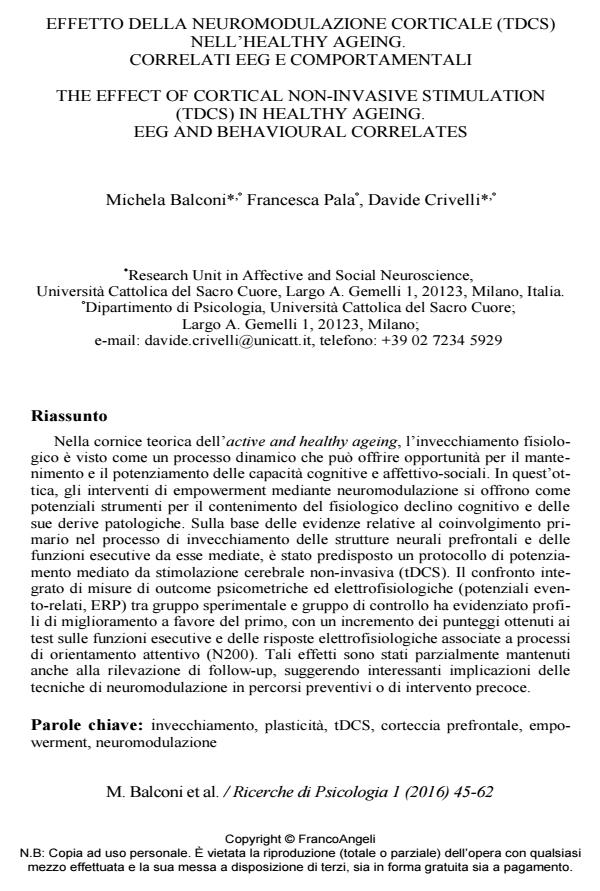The effect of cortical non-invasive stimulation (tdcs) in healthy ageing. Eeg and behavioural correlates
Journal title RICERCHE DI PSICOLOGIA
Author/s Michela Balconi, Francesca Pala, Davide Crivelli
Publishing Year 2016 Issue 2016/1
Language Italian Pages 18 P. 45-62 File size 90 KB
DOI 10.3280/RIP2016-001004
DOI is like a bar code for intellectual property: to have more infomation
click here
Below, you can see the article first page
If you want to buy this article in PDF format, you can do it, following the instructions to buy download credits

FrancoAngeli is member of Publishers International Linking Association, Inc (PILA), a not-for-profit association which run the CrossRef service enabling links to and from online scholarly content.
According to the active and healthy ageing theoretical framework, physiological ageing is a dynamic process characterized even by opportunities for maintaining and strengthening cognitive and affective-social skills. Empowerment by neuromodulation protocols may then act as useful tools to contrast physiological cognitive decline and potential pathological development. Moving from evidences on the primary role of prefrontal neural structures and prefrontal executive functions in the ageing process, we devised and tested a novel neuromodulation empowerment protocol using a non-invasive brain stimulation technique (tDCS). The integrated comparison of psychometric and electrophysiological (event-related potentials - ERP) outcome measures between the experimental and control groups pointed out that the former presented better performances at tests on executive functions and enhanced electrophysiological responses associated to attention control (N200). Such effects seem to be partially maintained even at a follow-up assessment, and that suggests interesting practical implications for the inclusion of neuromodulation techniques in prevention and early intervention projects.
Keywords: Aging, plasticity, tDCS, prefrontal cortex, empowerment, neuromodulation
- Neurocognitive Empowerment in Healthy Aging: a Pilot Study on the Effect of Non-invasive Brain Stimulation on Executive Functions Michela Balconi, Laura Angioletti, Federico Cassioli, Davide Crivelli, in Journal of Cognitive Enhancement /2021 pp.343
DOI: 10.1007/s41465-020-00203-2
Michela Balconi, Francesca Pala, Davide Crivelli, Effetto della neuromodulazione corticale (tdcs) nell’healthy ageing. Correlati eeg e comportamentali in "RICERCHE DI PSICOLOGIA " 1/2016, pp 45-62, DOI: 10.3280/RIP2016-001004